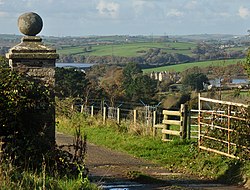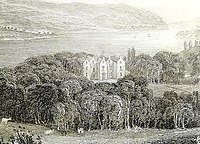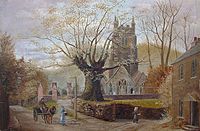Warleigh House
| Warleigh House | |
| Devon | |
|---|---|
 Warleigh House | |
| Location | |
| Grid reference: | SX45686171 |
| Location: | 50°26’6"N, 4°10’28"W |
| History | |
| For: | Rev. Walter Radcliffe by John Foulston |
| Country house | |
| Neo-Gothic | |
| Information | |
| Owned by: | Robert Kilroy-Silk |
Warleigh House is a country house presideing over the Warleigh Estate within the parish of Bickleigh, six miles from Plymouth, in Devon. The house was formerly the manor house of the manor of Tamerton Foliot and is to be found one mile west of that village on the south-east bank of the River Tavy where it joins the River Tamar.
The house was remodelled in about 1830 in the Gothic style by John Foulston. Today it remains a private house. It is a Grade II* listed building.[1]
The boundary walls of the garden are made from red brick and date from the 18th century and are Grade II listed.[2] The red brick dovecote to the east of the main house dates from the early 18th century and is Grade II listed.[3] The boat house to the south west of the house was built c.1800 in the Gothic style, and is Grade II listed.[4]
Contents
History
The estate before today's house
During the reign of King Stephen (1135–1154) Warleigh and the manor of Tamerton were held by Sampson Foliot. Risdon states:[5]
- "(His) principal place of dwelling was at Warleigh within the same parish, a seat both pleasant and profitable, situated by the Tamer side, having a fair demesne and a park adjoining, wanting no necessaries that land or sea afford".
After the death of Robert Foliot in the thirteenth century, his estates, including Warleigh, Tamerton Foliot and Tavy Foliot, were inherited by his daughter, Ellen Foliot, through whom they passed to the Gorges family, and later the estates came to the Copleston family, with whom Warleigh remained until the early modern period.
John IV Copleston (1546/9-1608) married Susan Pollard, a daughter of Lewis II Pollard of King's Nympton. The couple's monument, erected in 1617 and repaired in 1894, survives in St Mary's Church, Tamerton Foliot,[6] with a standad Latin epitaph praising the virtues of both and calling John Copleston "a man famed as greatly for true virtue as noble descent". As related by John Prince however, John IV Copleston murdered his godson, possibly an illegitimate son, which "most unfortunate occurrence in this place of Tamerton...in all probability hastened the extinction of the name and family here and at Copleston also".[7] The godson had been sent abroad for his education and when he returned home to England overheard his godfather's private conversation and reported it amongst his circle of friends, which action soon found its way by gossip back to his godfather, whose indignation was "exceedingly enkindled" and who exclaimed: "Must boys observe and discant on the actions of men and of their betters?", and thenceforth resolved and sought all opportunities to be revenged upon him. The two next met at Tamerton Foliot church during the Sunday service, and the youth fled before the end of the service, having noticed his godfather's angry look. Having received a message from his godfather that his anger was over and that he could return to church, the youth appeared at church the next week at the usual time. However Copleston's rage was not over, and although the youth had again fled before the end of the service, Copleston followed him and threw a dagger into his back, which killed him instantly. Copleston fled, and implored all his influential friends at the royal court to procure him a pardon from Queen Elizabeth, which eventually he received, but not without having had to pay a large fine which necessitated the sale of thirteen of his manors in Cornwall. This story is related by Prince, who heard it from a gentleman who was a neighbour of the Coplestons.[7]
The last if the Copleston's of Warleigh was John V Copleston (1609–1632), who died aged 23 without children. His two sisters inherited the estates and sold the manor of Copleston in 1659.[8] Tamerton Foliot was received by on of the sisters, Gertrude Coplestone, who married Sir John Bampfylde, from whom the manor descended therafter. In 1741 Sir Richard Warwick Bampfylde sold the manor of Tamerton Foliot, with its manor house of Warleigh, to the husband of his cousinin-law Walter Radcliffe.
The new house
Between 1825 and 1832 the Rev. Walter Radcliffe remodelled the house in the Gothic style to the designs of the architect John Foulston (1772–1841).[9]
In 1960, Warleigh House was used as a nursing home.[1] In 1986 the Radcliffe family continued to reside at a nearby estate.[10]
In 1998, the house and 111 acres of land was purchased by David Piper, a property developer and hotel owner. After his death in 2014, Warleigh House was bought by a Mr Clayton, who refurbished it and briefly operated the house as a three-bedroom luxury hotel.
In 2015, the house was bought by the television personality Robert Kilroy Silk, and it was returned its original purpose as a private residence.[11]
Outside links
| ("Wikimedia Commons" has material about Warleigh House) |
References
- ↑ 1.0 1.1 National Heritage List 1162274: Warleigh House
- ↑ National Heritage List 1107483: Garden boundary walls immediately south south east of Warleigh House
- ↑ National Heritage List 1107484: Dovecote east of Warleigh House
- ↑ National Heritage List 1309685: Boat House immediately west-south-west of Warleigh House
- ↑ Risdon, p.209
- ↑ Pevsner, p.679
- ↑ 7.0 7.1 Prince, p.237
- ↑ Hoskins, W.G.: 'A New Survey of England: Devon' (1954, 1959) p.372
- ↑ Pevsner, p.889
- ↑ See
- ↑ See
- Nikolaus Pevsner: The Buildings of England: Devon, 1952; 1989 Penguin Books ISBN 978-0-300-09596-8

